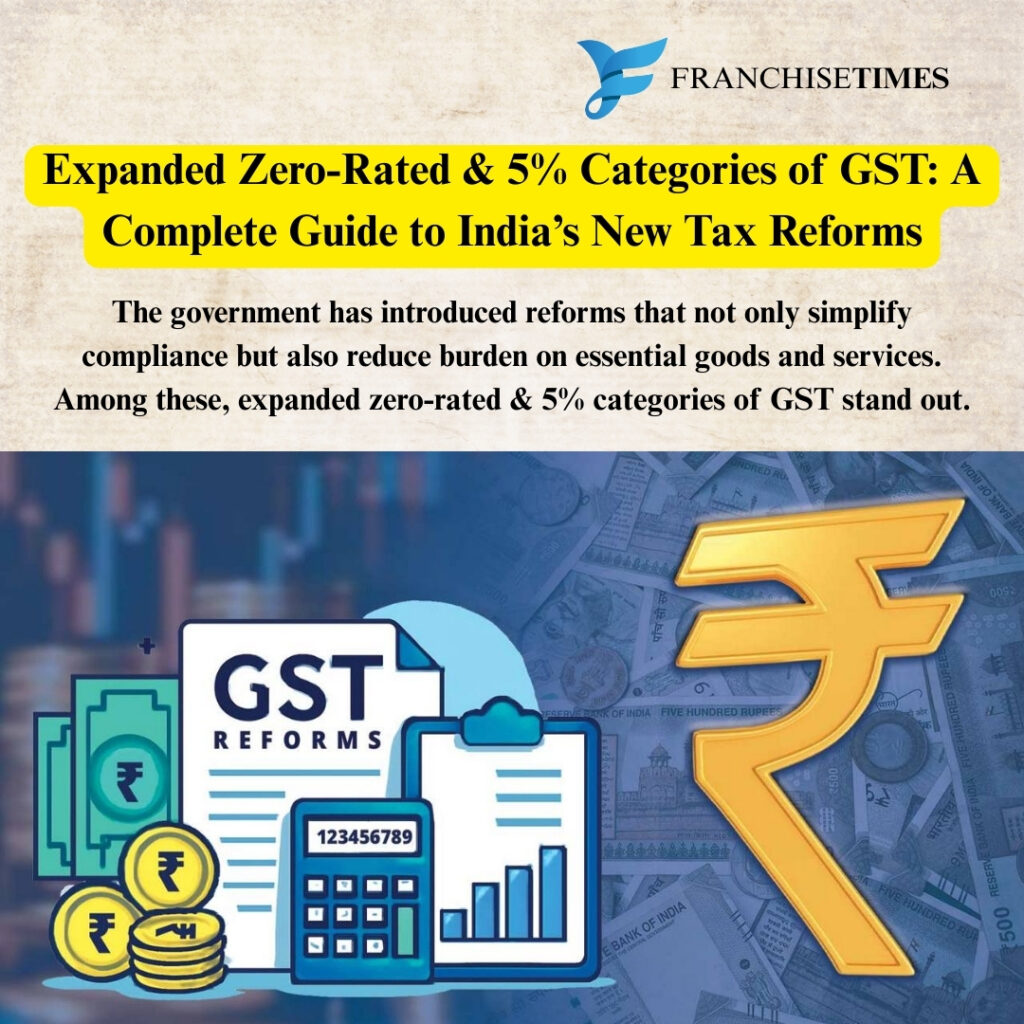Expanded Zero-Rated & 5% Categories of GST: A Complete Guide to India’s New Tax Reforms
The Goods and Services Tax (GST) has reshaped the Indian economy by streamlining indirect taxation. Businesses, consumers, and policymakers continue to study its impact closely. Over the years, the government has introduced reforms that not only simplify compliance but also reduce the burden on essential goods and services. Among these reforms, the Expanded GST Categories India stand out.

These categories are significant because they influence the cost of living, consumption patterns, and business growth. Zero-rated supplies reduce the tax liability on exports and select goods, while the 5% slab benefits sectors crucial to everyday life. Understanding these categories helps businesses plan pricing strategies and assists consumers in making informed choices.
In this detailed guide, we will explore the expanded zero-rated & 5% categories of GST, their importance, recent changes, and their broader impact on the economy.
1. Understanding Zero-Rated GST and Its Expansion
Zero-rated supplies under GST include exports and select services. Unlike exempted goods, zero-rated items allow businesses to claim an input tax credit (ITC). This mechanism ensures exporters remain competitive in the global market without carrying an embedded tax burden.
Originally, zero-rated supplies were limited to exports of goods and services and supplies to Special Economic Zones (SEZs). However, the Expanded GST Categories India of GST have widened this scope. The government recognized that certain goods and services are vital to economic growth, and reducing tax on them directly boosts affordability and competitiveness.
Recent reforms have expanded zero-rated categories to include:
- Specific medical supplies during public health emergencies.
- Export-oriented services that attract global clients.
- Renewable energy components that encourage sustainable growth.
This expansion serves two purposes. First, it supports essential sectors like healthcare and green energy. Second, it aligns India’s tax structure with global best practices, ensuring fair competition.
2. The 5% GST Category: Making Essentials Affordable
The 5% GST category covers goods and services that are important for the daily lives of citizens. When the GST regime began, items such as basic food products, household essentials, and select services were placed in this lower slab. Over time, the expanded zero-rated & 5% categories of GST introduced more items to ease inflationary pressures.
Currently, the 5% category includes:
- Essential food items like cereals, pulses, and edible oils.
- Public transport services, excluding luxury options.
- Healthcare services, including diagnostic and preventive care.
- Books, printed newspapers, and educational materials.
By keeping these goods and services in the 5% slab, the government ensures affordability for common households. At the same time, businesses dealing in these products face lower compliance costs compared to higher tax slabs.
Recent reforms have added renewable energy devices, affordable housing projects, and essential medicines to this category. These inclusions highlight the government’s intent to balance revenue generation with public welfare.
3. Economic Impact of Expanded Zero-Rated & 5% Categories
The expanded zero-rated & 5% categories of GST have multiple ripple effects across India’s economy. Their impact can be viewed from three perspectives: businesses, consumers, and government revenue.
Impact on Businesses
Businesses benefit from lower tax liability on raw materials and finished products. Exporters, in particular, gain by selling goods without embedded taxes, improving their global competitiveness. Additionally, companies in renewable energy, healthcare, and housing sectors attract higher demand due to reduced end prices.
Impact on Consumers
For consumers, affordability is the biggest advantage. Reduced GST on essentials helps families manage household budgets better. Access to affordable healthcare, food, and housing ensures a higher standard of living. Transitioning more items into the 5% slab further strengthens consumer trust in the GST system.
Impact on Government Revenue
Some experts argue that expanding low-tax categories reduces short-term revenue. However, broader consumption and improved compliance balance this effect. Over time, the government benefits from higher economic activity, job creation, and indirect revenue streams.
Thus, the reform does not weaken government finances. Instead, it encourages sustainable growth by fostering higher demand across multiple sectors.
4. Key Sectors Benefiting from the Expansion
The expanded zero-rated & 5% categories of GST have strategically supported sectors that drive economic development. Let us look at the major beneficiaries:
Healthcare
During the COVID-19 pandemic, medical supplies like oxygen concentrators, vaccines, and essential medicines were temporarily shifted into zero-rated or low-tax categories. This change not only made them affordable but also saved lives. Even today, essential medicines and medical devices enjoy lower GST.
Renewable Energy
To promote sustainability, solar panels, wind turbines, and other renewable devices fall under the 5% category. This move has boosted India’s renewable energy capacity and attracted foreign investments.
Education
Printed books, educational materials, and digital learning services continue to remain in the 5% slab. This ensures affordable access to knowledge, which directly impacts skill development and employability.
Housing
Affordable housing projects also benefit from reduced GST. By lowering the tax burden on such projects, the government helps middle-class families achieve home ownership dreams.
Export-Oriented Industries
Zero-rated exports strengthen India’s manufacturing and service exports. Sectors such as textiles, IT services, and agriculture gain significantly, positioning India as a stronger global supplier.
5. The Road Ahead: Future of GST Reforms
The expanded zero-rated & 5% categories of GST reflect the government’s adaptive approach. However, experts believe further reforms are necessary to achieve a balanced system.
Simplification of Rates
Currently, GST has multiple slabs. Businesses often face compliance challenges. Many economists suggest merging slabs into fewer categories for simplicity.
Digital Compliance
With the rise of digital platforms, compliance through automated systems will reduce errors. E-invoicing, AI-driven audits, and simplified returns will strengthen trust in the system.
Sector-Specific Relief
As new sectors emerge—like electric vehicles and green hydrogen—the government may add them to low-tax categories. This will not only encourage innovation but also keep India competitive.
Balancing Revenue and Welfare
While low GST rates benefit citizens, the government must ensure sustainable revenue. Therefore, widening the tax base and ensuring compliance will be key in the coming years.
Conclusion: Why These Categories Matter More Than Ever
The Expanded GST Categories India of GST represent more than just tax changes. They signal the government’s focus on balancing affordability, competitiveness, and economic growth. By placing essentials, exports, and emerging sectors under these slabs, India strengthens its domestic economy while boosting global competitiveness.
For businesses, this reform provides an opportunity to grow without heavy tax burdens. For consumers, it guarantees affordability in critical sectors like food, healthcare, housing, and education. And for policymakers, it reflects a strategy that supports both public welfare and long-term revenue stability.
As GST reforms continue to evolve, these categories will remain central to India’s economic journey. Every business leader, policymaker, and consumer must understand their importance to adapt effectively to the changing tax landscape.
